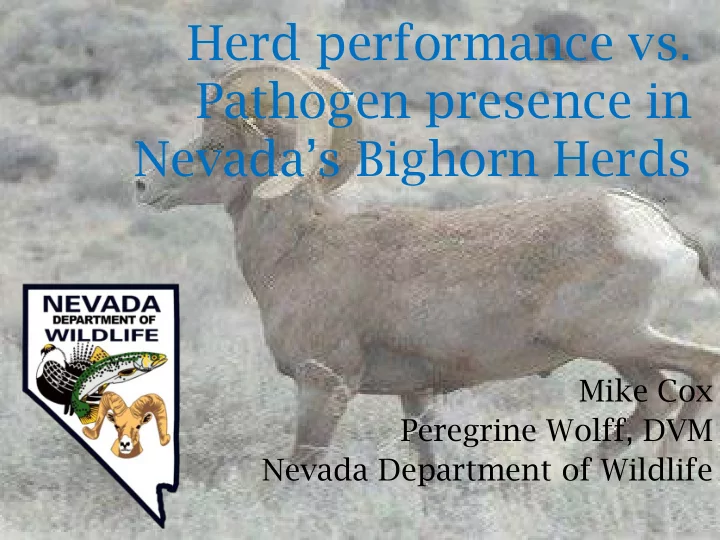

Herd performance vs. Pathogen presence in Nevada’s Bighorn Herds Mike Cox Peregrine Wolff, DVM Nevada Department of Wildlife
Epizootic pneumonia of bighorn sheep or an all age, die-off Polymicrobial pneumonia that is initiated by infection with the bacteria Mycoplasma ovipneumoniae or M. ovi
Bacteria that live in the back of the throat move down to the lungs causing pneumonia
4 outcomes for our sheep herds Only herds where we have: • Samples from the die-off • Pre and post herd performance data
First outcome All age, die-off with complete loss of herd Hays Canyon -2007 Speculative: Jarbidge – 1981 Tobins- early ‘90s
Second outcome All age die-off with a 1-2 years of poor lamb recruitment then bounce back Fairview –Slate 2007 Speculative: Ruby Mountains - 1997 East Humboldt – 1997 Mormons - 1981
Third outcome All age die-off with a 1-20 years of poor or variable lamb recruitment and no bounce back Santa Rosa range – 2004 Speculative: East Humboldt’s – 2009 Sheep Range - 1986 Ruby Mountains - 2009 Egans – 2008 Snowstorms – 2011 Mt. Moriah - 1991 Pancakes – 2011 White Pine/Duckwater Hill-2011 Pilot/Leppy Hills - 2010
Fourth outcome Some deaths but very minor negative herd response Lone Mountain Gabbs Valley Silver Peaks Monte Cristo Range Speculative: River Mountains Eldorados McCulloughs Spring Range
Outcome for herds unknown Bare Mtn. Stonewall NTTR Montanas East Humboldt – Rocky Mountain Bighorn Sheep River Mountains Eldorados McCullough Mtn. Spring Range
Why Variable Outcomes? Pathogen related • Chronic Carriers • Strain type Herd Density Nutrition Genetics Other Environmental factors
5-20% of survivors may still carry the bacteria
Similar to many pathogens, there are multiple strains of M. ovi which gives us a clue as to the origin of the infection
Mojave Strain Southern Nevada Strain 11/ 11/ 2013 2013
Mojave Strain Southern Nevada Strain 11/ 11/ 2015 2015
Fa Fairv irview/Sla late/Sand S d Sprin prings/Monte Cris risto, , Unit it 1 181 400 400 60.0 60.0 350 350 ate 50.0 50.0 imat 300 300 ion Estim 40.0 40.0 io 250 250 atio amb Rat atio 200 200 30.0 30.0 Populat Lam 150 150 20.0 20.0 rd P 100 100 Herd 10.0 10.0 50 50 0 0.0 0.0 1996 1996 1999 1999 2002 2002 2005 2005 2008 2008 2011 2011 2014 2014 Lamb Ratio Population Estimate
Mormo Mor mon Mount Mountains ns, U Uni nit 2 t 271 500 500 70. 70.0 450 450 60.0 60. 400 400 te imate 50.0 50. 350 350 ion Estim 300 300 tio Lamb Ratio 40.0 40. latio 250 250 Herd Popula 30. 30.0 200 200 150 150 20.0 20. 100 100 10.0 10. 50 50 0 0. 0.0 1975 1978 1975 1978 1981 1981 1984 1984 1987 1987 1990 1990 1993 1993 1996 1996 1999 1999 2002 2002 2005 2005 2008 2008 2011 2011 2014 2014 Lamb Ratios Population Estimate
McCu cCullough Ran Range, U Unit 263 263 500 500 80.0 80. 450 450 70. 70.0 400 400 ate 60.0 60. imat 350 350 ion Estim 50.0 50. io 300 300 atio amb Rat atio 250 250 40. 40.0 Populat Lam 200 200 30. 30.0 rd P Herd 150 150 20.0 20. 100 100 10.0 10. 50 50 0 0.0 0. 1981 1981 1984 1984 1987 1987 1990 1990 1993 1993 1996 1996 1999 1999 2002 2002 2005 2005 2008 2008 2011 2011 2014 2014 Lamb Ratios Population Estimate
River Mountains, Unit 269 70.0 400 350 60.0 300 Herd Population Estimate 50.0 250 Lamb Ratio 40.0 200 30.0 150 20.0 100 10.0 50 0 0.0 1986 1989 1992 1995 1998 2001 2004 2007 2010 2013 Lamb Ratios Population Estimate Survey Total
Spring Mountains, Unit 262 350 100.0 90.0 300 80.0 Herd Population Estimate 250 70.0 Lamb Ratio 60.0 200 50.0 150 40.0 30.0 100 20.0 50 10.0 0 0.0 1980 1983 1986 1989 1992 1995 1998 2001 2004 2007 2010 2013 Lamb Ratios Population Estimate
Gabbs Valley/Gillis Ranges, Unit 205 and 207 700 70.0 600 60.0 Herd Population Estimate 500 50.0 Lamb Ratio 400 40.0 300 30.0 200 20.0 100 10.0 0 0.0 1984 1987 1990 1993 1996 1999 2002 2005 2008 2011 2014 Lamb Ratios Population Estimate
Monte Cristo Range, Unit 213 700 90.0 80.0 600 70.0 Herd Population Estimate 500 60.0 Lamb Ratio 400 50.0 40.0 300 30.0 200 20.0 100 10.0 0 0.0 1980 1983 1986 1989 1992 1995 1998 2001 2004 2007 2010 2013 Lamb Ratios Population Estimate
Santa Rosa Range, Unit 051 350 80.0 70.0 300 Herd Population Estimate 60.0 250 50.0 Lamb Ratio 200 40.0 150 30.0 100 20.0 50 10.0 0 0.0 1980 1983 1986 1989 1992 1995 1998 2001 2004 2007 2010 2013 Lamb Ratios Population Estimate
Pancake Range, Unit 134 350 80.0 70.0 300 Herd Population Estimate 60.0 250 50.0 Lamb Ratio 200 40.0 150 30.0 100 20.0 50 10.0 0 0.0 1985 1988 1991 1994 1997 2000 2003 2006 2009 2012 2015 Lamb Ratios Population Estimate
Recommend
More recommend